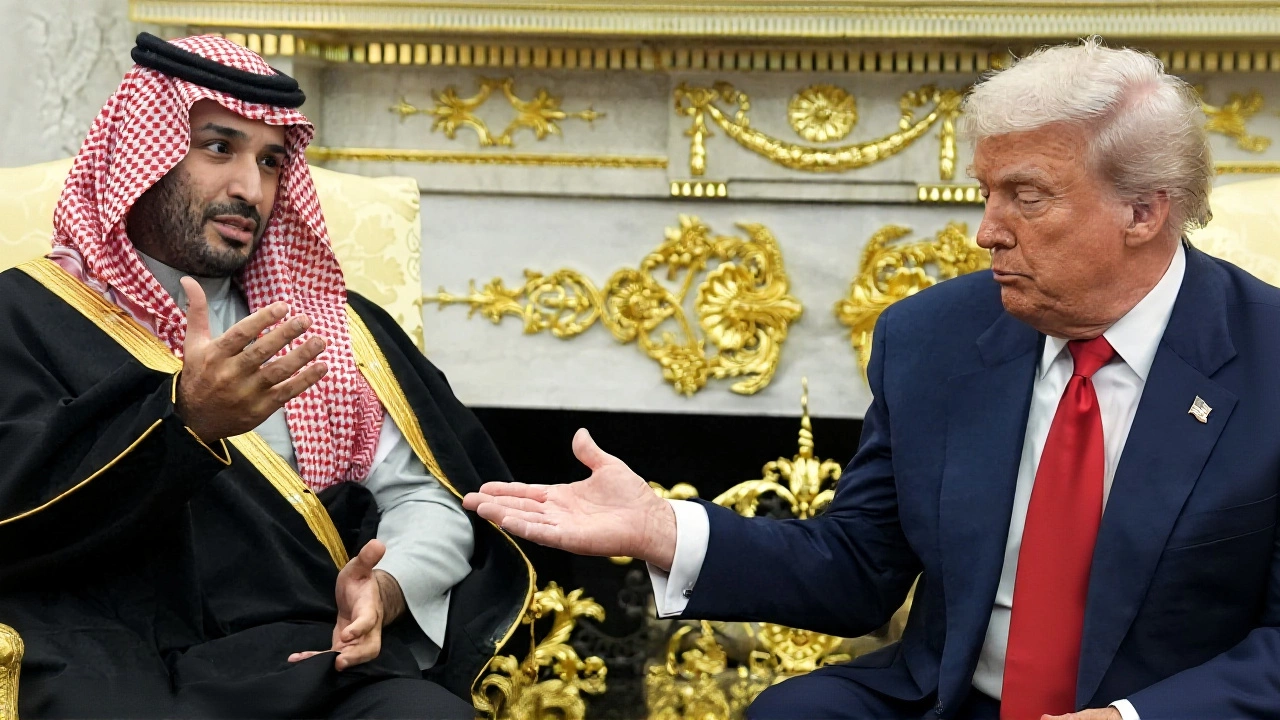When Donald Trump welcomed Mohammed bin Salman to the White House on November 18, 2025, it wasn’t just another diplomatic handshake. It was the opening of a new chapter in U.S.-Saudi ties — one written in billions of dollars, fighter jets, and artificial intelligence code. The visit, which began with a formal greeting on the North Portico and ended with a tearful farewell on the South Lawn, produced the largest arms package in the history of the two nations’ 92-year relationship. And behind the velvet ropes and candlelit dinners, something even more consequential was being forged: a technological and strategic alliance that could reshape the Middle East’s balance of power.
A Day in the Life of a Historic Visit
The day started at 10:00 a.m. EST, when the Crown Prince’s motorcade rolled through the gates of the White House complex at 1600 Pennsylvania Avenue NW. By 10:30 a.m., he and Trump were locked in the Oval Office for 97 minutes — longer than scheduled. According to White House notes, the conversation veered from defense contracts to AI ethics. At 1:15 p.m., they moved to the State Dining Room for a working lunch that lasted over an hour and a half. No menus were released, but sources say the conversation didn’t pause for dessert. By 7:00 p.m., the East Room had transformed into a glittering gala. Diplomats, defense contractors, and tech executives mingled under chandeliers as Trump toasted the Crown Prince as “a tremendous partner for the United States.”The $127 Billion Agenda
The numbers tell the real story. The two leaders agreed on potential bilateral deals totaling $127 billion. That includes a $15.3 billion defense contract for U.S. military hardware — the biggest single arms sale in U.S.-Saudi history. The package includes 48 F-35 fighter jets, 24 THAAD missile defense systems, and 12 Arleigh Burke-class destroyers. These aren’t just weapons; they’re strategic anchors. The F-35s alone will give Saudi Arabia air superiority unmatched in the region. The THAAD systems? Designed to intercept ballistic missiles — a clear signal to Iran. Then there’s the $7.8 billion AI joint venture. The deal, brokered between Lockheed Martin and Saudi Arabia’s Public Investment Fund, will establish an AI research hub in Riyadh focused on defense analytics, autonomous systems, and predictive cyberwarfare. “This isn’t about gadgets,” said a senior Pentagon official who spoke on condition of anonymity. “It’s about building a shared operational language between our militaries — one that runs on algorithms, not just orders.”
Nuclear Energy and the Israel Factor
Perhaps the most delicate topic was nuclear energy. Saudi Arabia has long sought a civilian nuclear program — and the U.S. is now willing to help, under strict safeguards. While no formal agreement was signed, both sides agreed to a “framework for peaceful nuclear cooperation,” with U.S. experts set to begin technical assessments in January. The goal? To prevent proliferation while allowing Saudi Arabia to generate electricity and desalinate water. And then there’s Israel. The White House press release from November 17 explicitly mentioned “potential normalization of relations” between Riyadh and Jerusalem. It’s the elephant in the room that no one named outright — but everyone knew was there. Saudi Arabia has refused to recognize Israel for decades. But with Iran’s nuclear ambitions growing and Russia’s influence in Syria expanding, the Crown Prince may be recalculating his regional calculus. “The Saudis aren’t asking for a peace treaty,” said a former U.S. ambassador to Riyadh. “They’re asking for a quiet handshake — and the U.S. is holding the pen.”Why This Matters Beyond the Headlines
This isn’t just about weapons sales or tech deals. It’s about the future of American influence in the Gulf. For years, the U.S. has relied on Saudi Arabia as a regional stabilizer — even as its human rights record drew global criticism. This visit signals a new bargain: access to advanced U.S. tech and arms in exchange for geopolitical alignment. It’s the same logic that underpinned the 1945 meeting between President Roosevelt and King Abdulaziz — but now, the currency is data, not oil. The Royal Embassy of Saudi Arabia called the visit a “strengthening of the special strategic relationship” dating back to May 1, 1933. That’s not empty diplomacy. It’s a reminder that this alliance has survived presidents, revolutions, and wars. And now, it’s being upgraded for the AI age.
What’s Next? The December Deadline
Implementation teams from both nations will meet in Riyadh from December 5–7, 2025, to finalize contracts. If they reach agreement, the first F-35s could arrive in Saudi skies by late 2027. The AI hub is slated to open in 2028. And if normalization talks with Israel progress, the region could see its most significant geopolitical shift since the 1979 Iranian Revolution. The world watched. The markets reacted. And in the quiet corridors of the Pentagon, analysts are already drafting contingency plans — because when Saudi Arabia buys this much American hardware, it doesn’t just change the balance of power. It changes the rules of the game.Frequently Asked Questions
What makes this arms deal the largest in U.S.-Saudi history?
The $15.3 billion defense package includes 48 F-35 stealth fighters, 24 THAAD missile interceptors, and 12 Arleigh Burke-class destroyers — a combination never before offered to any Gulf state. Previous deals, like the 2017 $110 billion package under Trump’s first term, were spread across dozens of smaller contracts. This one is concentrated, high-impact, and includes cutting-edge systems previously restricted to NATO allies.
Why is the U.S. now willing to help Saudi Arabia with nuclear energy?
The U.S. is offering technical support under strict IAEA safeguards, partly to counter Iran’s nuclear program and prevent Saudi Arabia from turning to Russia or China for reactors. The goal is to give Riyadh a civilian nuclear option — for power and desalination — while ensuring no weapons-grade material is produced. It’s a calculated risk: trust, but verify.
How does this affect the prospects of Saudi-Israeli normalization?
While no formal agreement was announced, the visit signaled a major shift. Saudi Arabia has conditioned recognition of Israel on Palestinian statehood — but with Iran’s threats growing and the U.S. pushing for regional alliances, Riyadh may now be willing to trade quiet cooperation for advanced defense tech. U.S. officials say “quiet normalization” — no public ceremony, but intelligence sharing and economic ties — could begin within 18 months.
What role does artificial intelligence play in this partnership?
The $7.8 billion AI joint venture between Lockheed Martin and Saudi Arabia’s PIF will develop autonomous targeting systems, cyber defense tools, and predictive logistics platforms. Unlike past tech transfers, this involves co-development — meaning Saudi engineers will build the code. It’s a strategic pivot: the U.S. isn’t just selling tech; it’s embedding its influence into Saudi military decision-making.
Is there opposition to this deal in the U.S. Congress?
Yes. Several Democratic senators, including Chris Murphy and Elizabeth Warren, have signaled they’ll block funding for F-35 exports unless Saudi Arabia improves its human rights record. But with Republicans controlling the Senate and the defense industry lobbying heavily, the deal is expected to pass. The real hurdle may come from public opinion — polls show 58% of Americans oppose arms sales to Saudi Arabia after the Khashoggi killing.
What’s the timeline for delivering the weapons and tech?
The F-35s are expected to begin delivery in late 2027, with full fleet operational by 2030. THAAD systems will be deployed by 2028, and the destroyers will be built in U.S. shipyards, with first delivery in 2029. The AI hub in Riyadh is scheduled to open in 2028, with pilot programs launching in 2026. The nuclear framework will be finalized by June 2026, with construction of a pilot reactor starting in 2027.
